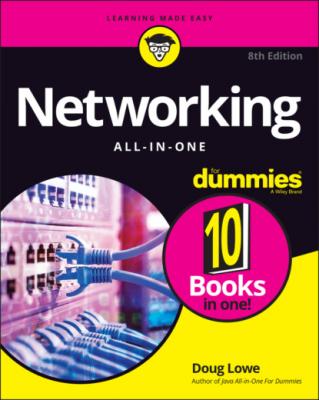Networking All-in-One For Dummies. Doug Lowe
Читать онлайн.| Название | Networking All-in-One For Dummies |
|---|---|
| Автор произведения | Doug Lowe |
| Жанр | Зарубежная компьютерная литература |
| Серия | |
| Издательство | Зарубежная компьютерная литература |
| Год выпуска | 0 |
| isbn | 9781119689058 |
Protocols come in many different types. At the lowest level, protocols define exactly what type of electrical signal represents a 1 and what type of signal represents a 0. At the highest level, protocols allow (say) a computer user in the United States to send an email to another computer user in New Zealand — and in between are many other levels of protocols. You find out more about these levels of protocols (often called “layers”) in the upcoming section, “Seeing the Seven Layers of the OSI Reference Model.”
Understanding Standards
As I mention earlier, a standard is an agreed-upon definition of a protocol. In the early days of computer networking, each computer manufacturer developed its own networking protocols. As a result, you couldn’t easily mix equipment from different manufacturers on a single network.
Then along came standards to save the day. Hurrah! Because standards are industry-wide protocol definitions not tied to a particular manufacturer, you can mix and match equipment from different vendors. As long as the equipment implements the standard protocols, it should be able to coexist on the same network.
Many organizations are involved in setting standards for networking. The five most important organizations are
American National Standards Institute (ANSI; www.ansi.org): The official standards organization in the United States. ANSI is pronounced AN-see.
Institute of Electrical and Electronics Engineers (IEEE; www.ieee.org): An international organization that publishes several key networking standards — in particular, the official standard for the Ethernet networking system (known officially as IEEE 802.3). IEEE is pronounced eye-triple-E.
International Organization for Standardization (ISO; www.iso.org): A federation of more than 100 standards organizations throughout the world. If you’re wondering why the acronym for International Organization for Standardization is ISO and not IOS, the answer is simple: ISO is truly an international organization, and although it is known as the International Organization for Standardization in English-speaking countries, it goes by different names in non-English-speaking countries — for example, in French-speaking countries, it’s known as Organisation internationale de normalisation. The organization’s founders chose ISO so that it would have the same short name in all languages.
Internet Engineering Task Force (IETF; www.ietf.org): The organization responsible for the protocols that drive the Internet.
World Wide Web Consortium (W3C; www.w3.org): An international organization that handles the development of standards for the World Wide Web.
Seeing the Seven Layers of the OSI Reference Model
“OSI” sounds like the name of a top-secret government agency you hear about only in Tom Clancy novels. What it really stands for in the networking world is Open Systems Interconnection, as in the Open Systems Interconnection Reference Model, affectionately known as the OSI model.
The OSI model breaks the various aspects of a computer network into seven distinct layers. These layers are kind of like the layers of an onion: Each successive layer envelops the layer beneath it, hiding its details from the levels above. The OSI model is also like an onion in that if you start to peel it apart to have a look inside, you’re bound to shed a few tears.
The OSI model is not a networking standard in the same sense that Ethernet and TCP/IP are networking standards. Rather, the OSI model is a framework into which the various networking standards can fit. The OSI model specifies what aspects of a network’s operation can be addressed by various network standards. So, in a sense, the OSI model is sort of a standard of standards.
Table 1-1 summarizes the seven layers of the OSI model.
TABLE 1-1 The Seven Layers of the OSI Model
| Layer | Name | Description |
|---|---|---|
| 1 | Physical | Governs the layout of cables and devices, such as repeaters and hubs. |
| 2 | Data link | Provides Media Access Control (MAC) addresses to uniquely identify network nodes and a means for data to be sent over the physical layer in the form of packets. Bridges and switches are layer 2 devices. |
| 3 | Network | Handles routing of data across network segments. |
| 4 | Transport | Provides for reliable delivery of packets. |
| 5 | Session | Establishes sessions between network applications. |
| 6 | Presentation | Converts data so that systems that use different data formats can exchange information. |
| 7 | Application | Allows applications to request network services. |
The first three layers are sometimes called the lower layers. They deal with the mechanics of how information is sent from one computer to another over a network. Layers 4 through 7 are sometimes called the upper layers. They deal with how application software can relate to the network through application programming interfaces.
The following sections describe each of these layers in greater detail.
The physical layer
The
